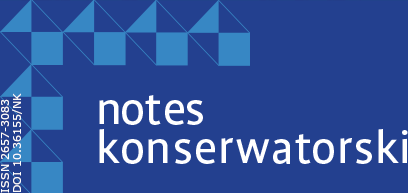
STRONA REDAKCYJNA, s. 2 / CREDITS, p. 2
SPIS RZECZY, s. 4–7 / CONTENTS, p. 4–7
POLITYKA OCHRONY I KONSERWACJI ZBIORÓW / PRESERVATION AND CONSERVATION POLICY
Przeglądy magazynów bibliotecznych podstawą profilaktyki konserwatorskiej, s. 15–57 / Inspections of Library Storage Space as a Fundament of Preventive Conservation, p. 15–57
Preventive conservation of library materials during their storage and sharing is one of the most important tasks of librarians and conservators who supervise the holdings. Whether incorporated into the National Heritage Collections or not, all libraries that have collections of exceptional value and significance to the national heritage should follow the same protection guidelines. The article presents a system of inspecting library storage space of the National Library of Poland that was developed by its Institute for Conservation of Library Collections. The system involves regular (yearly) on-site inspections by a dedicated committee of all elements connected with storing the holdings. Conservation guidelines have been set out for the National Library of Poland’s employees who work with original library materials temporarily extracted from the store rooms (for cataloguing, inventorying, adding shelfmarks and security tags, digitization, sharing and lending out for expositions etc.) in the document Zasady właściwego postępowania z materiałami bibliotecznymi poza magazynami bibliotecznymi Biblioteki Narodowej [Rules of proper handling of library materials outside the National Library of Poland’s storage rooms]. A compulsory course in chosen aspects of preventive conservation was prepared and held by the specialists from the aforementioned Institute. At the end of the article one can find a selection of basic publications in Polish concerning preventive conservation and protective conservation.
Instytut Konserwacji Zbiorów Bibliotecznych Biblioteki Narodowej – przegląd działalności 2015–2019, s. 59–90 / Work of the Institute for Conservation of Library Collections of the National Library of Poland in the Years 2015–2019: an Overview, p. 59–90
The article presents general information on the Institute for Conservation of Library Collections (IKZB) of the National Library of Poland in the years 2015–2019. It describes the current structure of the IKZB and how it has been shaped by challenges faced by conservators and renovators of library holdings. It serves as an introduction to more detailed texts concerning specific subunits of the IKZB that execute traditional conservation, conservation of single-sheet items and books, as well as the work of the conservation laboratory. Other activities of the IKZB beyond conservation as such: trainings, popularization, and participation in research and digitization projects. Particularly interesting is the IKZB’s involvement in the protection of the National Library Resources carried out by a team including employees from technical and administrative units of the National Library of Poland. Concise tables summarize official data on the work of the whole Institute from 2015 to 2018 (provided to the Ministry of Culture and National Heritage).
FIZYKA, CHEMIA I MIKROBIOLOGIA W OCHRONIE I KONSERWACJI ZBIORÓW / PHYSICS, CHEMISTRY AND MICROBIOLOGY IN PRESERVATION AND CONSERVATION
Badania efektywności odkwaszania papieru alkoholową dyspersją tlenku magnezu o rozmiarach nanometrycznych, s. 93–128 / The studies on effectivity of deacidification of paper using alcohol dispersion of magnesium oxide nanoparticles, p. 93–128
The article describes the results of studies on the deacidification of model papers (Whatman) using nanodispersions of magnesium oxide (MgO) in 2-propanol. Preliminary experiments showed greater effectiveness of nanodispersion deacidification in comparison with the standard reagent which was applied in the form of micrometric particles. Further analyses compared the effectiveness of deacidification by immersion, spraying and brushing. Although all of the tested methods caused an increase in the pH of paper water extracts, the assays of magnesium contents using Inductively Coupled Plasma (ICP) method and Scanning Electron Microscopy with an Energy Dispersive X-ray spectrometer (SEM-EDX) showed greatest effectiveness of deacidification by immersion. SEM-EDX and spectroscopic analysis based on X-ray photoelectron spectroscopy (XPS) method showed the presence of sulfur and magnesium compounds, including the chemical linkages characteristic for magnesium sulfate, which proved effective neutralization. When comparing uniformity of magnesium application on the surface of the paper samples (mapping, SEM-EDX), it was found that the deacidification agent was distributed more uniformly when sprayed (in comparison to immersion).
Z PRAKTYKI KONSERWATORA / FROM A CONSERVATOR’S PRACTICE
Problemy konserwacji XIX-wiecznego rękopiśmiennego planu przedstawiającego działki gruntów z okolic wsi Dołhobrody, s. 131–160 / Issues in Conservation of a Nineteenth-Century Handwritten Map of Land Parcels Near Dołhobrody Village, p. 131–160
The article briefly describes the issues in the conservation of a nineteenth-century handwritten map covered with watercolors, ink, crayon and pencil, that is a property of a private owner. The object was the main subject of a master’s thesis by Piotr Popławski, prepared in the years 2017–2018 at the Faculty of Conservation and Restoration of Works of Art, Academy of Fine Arts in Warsaw, under the supervision of Prof. Marzenna Ciechańska, PhD. Due to the presence of water-sensitive painting layers and historical annotations in pencil, typical procedures used in paper conservation, i.e. aqueous bath and mechanical cleaning, could not be employed. Therefore, a novel approach was used: water cleaning with gellan gum – hydrogel, that has recently been introduced into paper conservation. The paper provides information on the history of the map, the technique and technology of its execution, its preservation state before conservation, issues in its conservation, as well as on the conservator’s approach to the process. It also presents the sequence of treatments applied and the conclusions drawn from them.
Dwóch bohaterów i tchórz. Konserwacja wielkoformatowych plakatów propagandowych z okresu wojny polsko-bolszewickiej, s. 161–189 / Two Heroes and a Coward. Conservation of Large-Format Propaganda Posters from the Polish-Soviet War Period, p. 161–189
On October 30th, 2018, the National Museum in Cracow opened an exhibition Niepodległość. Wokół myśli historycznej Józefa Piłsudskiego [Independence. Around the Historical Thought of Józef Piłsudski]. 779 works were presented. Among exhibits owned by the National Museum in Cracow which required conservation were large-format propaganda posters from the Polish-Soviet War period titled Tchórz [Coward] and Bohater [Hero]. Those pieces, executed with painting technique, were in a very bad condition. Due to their large size, they had been stored in tight rolls. Soiled and heavily stained sheets displayed extensive mechanical damage and deformations, and were covered in numerous creases and folds. The paint used by the artist proved highly sensitive to moisture and formed stains and tide marks. The fragments made with yellow paint showed vulnerable to friction – it underwent abrasion even under slight pressure. The author of the poster Tchórz, unsatisfied with unwanted effects, had improved his work by pasting fragments of a face, hands and feet cut out of the same paper onto the front of the painting. The entirety of the surface of the poster Bohater had been backed onto a sheet of the same paper with a similar image painted on. Conservation procedures resulted in stopping progressive destruction and eliminating its causes. The stuck together sheets of the poster Bohater were separated from each other. The painting layer was consolidated with the use of funori. After removing deformations, all objects were mechanically reinforced by lining with Japanese paper. All three of the posters were returned to a state closer to how it was intended to be viewed and after almost one hundred years were shown to the public.
Przygotowanie obiektów do digitalizacji w ramach projektu „Patrimonium” – realizacje konserwatorskie, s. 191–216 / Preparation of Items for Digitization Within the Scope of the „Patrimonium” Project: Conservation Procedures, p. 191–216
The article discusses the problem of conservation of early collections subjected to mass digitization within the scope of the „Patrimonium” project. The first part of the article outlines the key issues concerning the condition of the items that influence the digitization workflow, such as the presence, extent and intensity of physical, chemical and microbiological damage. It also addresses the problem of original technological structures of codices which often enough make scanning difficult or impossible. The second part focuses on conservator’s interventions, i.e. the application of procedures and treatments in the preparation of library holdings for scanning. Statistics are presented as regards the number of surveys and treated items during the two years of the „Patrimonium” project (2017–2018). Examples of conservation procedures applied to various types of objects are also provided.
Zabezpieczenie zbiorów bibliotecznych bez ich wyprowadzenia na czas remontu dachu w magazynach bibliotecznych, s. 217–228 / Protection of Library Collections During the Roof Repair Without Displacing Them from the Library Storage Rooms, p. 217–228
The article presents a report on the activities of the Institute for Conservation of Library Collections (IKZB) during the installation of insulation and leveling layers on an unvented flat roof subsequently covered with torch-on felt, and with photovoltaic panels mounted atop. These works were carried out within the scope of the project POIS.01.03.01-00-0057/16 „Modernizacja energetyczna w budynkach A Biblioteki Narodowej przy al. Niepodległości 213 w Warszawie” [Energetic refurbishment of the Buildings A of the National Library of Poland], part of the Infrastructure and Environment Programme, 2014–2020 („Reductions in industrial emissions”). The author describes the co-operation between different units within the National Library of Poland and the establishment of internal procedures for collections protection. He lists the tasks of the IKZB, such as: supervision of correct protection of library collections pending renovation, monitoring conditions in the storage rooms including measurements of temperature and humidity, as well as actions taken following the appearance of water stains, including microbiological examination of flooded space.
KONFERENCJE, WARSZTATY, WYDARZENIA / CONFERENCES, WORKSHOPS, EVENTS
Kalendarium wydarzeń 2018, s. 231–242 / Conferences, Workshops, Events Calendar of Events in 2018, p. 231–242

